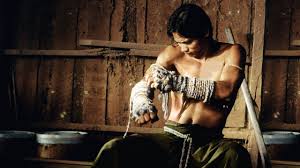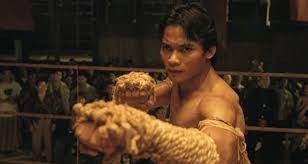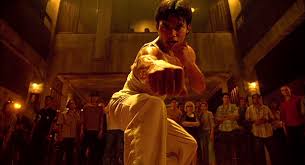🎬 Ong-Bak (2003)

Review of Ong-Bak (2003)
Praised for its groundbreaking action choreography and authentic martial arts sequences, Ong-Bak: The Thai Warrior (2003) is a thrilling showcase of physical prowess and cinematic ingenuity. Directed by Prachya Pinkaew and starring Tony Jaa in his breakout role, the film revitalized the martial arts genre with its raw intensity, practical stunts, and deep respect for traditional Muay Thai. Combining breathtaking action with a straightforward narrative, Ong-Bak remains a landmark film that captivated audiences worldwide.
Plot Overview
The story begins in a quiet rural village in Thailand, where the head of a sacred Buddha statue, Ong-Bak, is stolen by smugglers. Ting (Tony Jaa), a young and skilled Muay Thai fighter, volunteers to retrieve the relic and restore honor to his community. His quest takes him to the bustling streets of Bangkok, where he must confront a series of dangerous criminals, underground fight clubs, and morally corrupt antagonists.
While the plot is relatively simple, it serves as an effective backdrop for the film’s primary focus: jaw-dropping action sequences. Ting’s journey is less about character development and more about showcasing his unparalleled martial arts skills in a variety of escalating challenges.
Action and Choreography
1. The Physicality of Tony Jaa
At the heart of Ong-Bak’s success is Tony Jaa’s extraordinary athleticism and dedication to his craft. Unlike many action films that rely on CGI or wirework, Ong-Bak’s stunts are performed entirely without special effects. Jaa’s ability to execute intricate Muay Thai techniques, coupled with his fearless approach to stunt work, sets a new standard for authenticity in martial arts cinema.
Memorable sequences include Ting leaping through rings of barbed wire, performing acrobatic flips over moving vehicles, and engaging in brutal hand-to-hand combat. Each fight scene is meticulously choreographed to highlight the power, grace, and versatility of Muay Thai, making every punch, kick, and elbow strike feel impactful.
2. Innovative Set Pieces
The film’s action sequences are not only technically impressive but also creatively staged. From a chaotic chase through the narrow alleys of Bangkok to a high-stakes fight in an underground club, Ong-Bak keeps the audience engaged with its dynamic settings. The use of everyday objects as weapons—chairs, tables, and even frying pans—adds an element of unpredictability and excitement to the battles.
One standout moment is the bone-crunching fight atop a burning platform, where Ting’s resilience and resourcefulness are put to the ultimate test. These sequences demonstrate Prachya Pinkaew’s ability to blend traditional martial arts with inventive visual storytelling.
Themes and Cultural Significance
While Ong-Bak is primarily an action film, it also carries themes of cultural pride and spirituality. The theft of the Buddha’s head symbolizes the erosion of traditional values in the face of modern greed and corruption. Ting’s mission to recover the artifact reflects a deep reverence for heritage and morality, serving as a reminder of the importance of preserving cultural identity.
The film also shines a light on the exploitation and moral decay prevalent in urban environments. Ting’s journey from his peaceful village to the chaotic underbelly of Bangkok underscores the stark contrast between tradition and modernity, innocence and vice.
Performance and Characterization
Tony Jaa’s performance is a tour de force, blending physicality with a quiet, stoic charisma. While Ting is not a deeply complex character, Jaa’s earnest portrayal makes him a compelling hero. His commitment to his village and unwavering moral compass provide a strong emotional anchor for the film.
The supporting cast adds flavor to the story, particularly Petchtai Wongkamlao as Humlae (a.k.a. Dirty Balls), Ting’s reluctant ally. Humlae’s comedic antics and eventual redemption offer moments of levity amidst the intense action. The film’s villains, though somewhat one-dimensional, are effective in their roles, serving as worthy adversaries for Ting’s martial arts prowess.
Cinematography and Direction
Ong-Bak’s cinematography, led by Nattawut Kittikhun, captures the gritty realism of Bangkok’s streets and the serene beauty of rural Thailand. The camera work during action sequences is particularly noteworthy, employing long takes and wide angles to fully showcase Tony Jaa’s movements. This approach allows the audience to appreciate the choreography without the disorienting quick cuts often used in modern action films.
Director Prachya Pinkaew deserves credit for his ability to balance high-octane action with moments of introspection. By keeping the focus on Ting’s mission and the cultural significance of his quest, Pinkaew ensures that the film’s emotional core remains intact.
Legacy and Impact
Ong-Bak’s release marked a turning point for martial arts cinema, introducing a global audience to the raw power and artistry of Muay Thai. The film catapulted Tony Jaa to international stardom, paving the way for subsequent action stars to embrace practical stunts and traditional fighting styles.
Beyond its influence on the genre, Ong-Bak remains a cultural touchstone in Thai cinema. Its celebration of national identity, combined with its innovative action sequences, solidified its status as a modern classic. The film’s success also inspired a wave of similar productions, further cementing Thailand’s reputation as a hub for martial arts filmmaking.
Criticisms
While Ong-Bak excels in action and spectacle, its narrative and character development are relatively shallow. The plot’s simplicity may leave some viewers wanting more depth, and certain supporting characters lack the complexity needed to fully engage the audience. Additionally, the pacing occasionally falters during the film’s quieter moments, though these are minor drawbacks in an otherwise exhilarating experience.
Conclusion
Ong-Bak: The Thai Warrior is a groundbreaking achievement in martial arts cinema, showcasing the unparalleled talent of Tony Jaa and the timeless appeal of practical action filmmaking. Its blend of visceral fight sequences, cultural themes, and breathtaking stunts makes it a must-watch for fans of the genre.
Though its story may be straightforward, Ong-Bak’s heart lies in its celebration of resilience, tradition, and the human spirit. It remains a thrilling and inspiring film that continues to captivate audiences and set the gold standard for martial arts action. For anyone seeking an adrenaline-fueled cinematic experience, Ong-Bak delivers with style and substance.